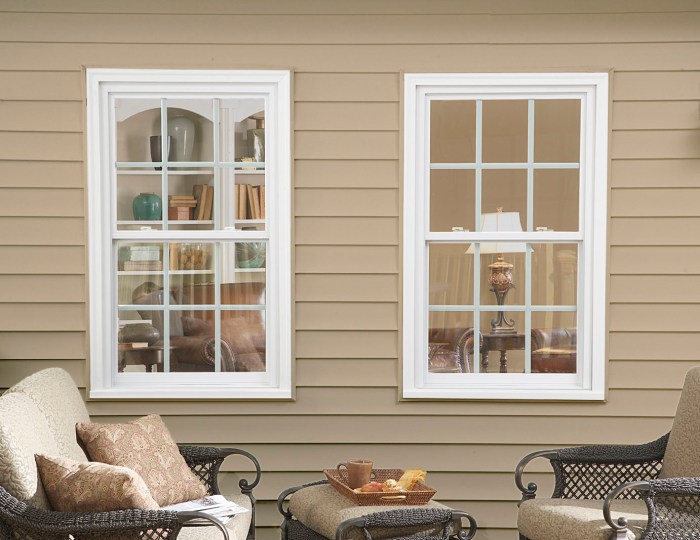Exploring the World of Exterior Windows
As exterior windows take center stage, this opening passage beckons readers into a world crafted with good knowledge, ensuring a reading experience that is both absorbing and distinctly original. From different types to materials used and design considerations, this topic delves into the crucial aspects of exterior windows that shape our buildings and homes.
Types of Exterior Windows

Exterior windows play a crucial role in a residential building's aesthetics, functionality, and energy efficiency. There are several common types of exterior windows that are widely used, each with its unique features and benefits.
Casement Windows
Casement windows are hinged on one side and open outward like a door, providing excellent ventilation and unobstructed views. They are easy to operate and seal tightly when closed, making them energy-efficient.
Double-Hung Windows
Double-hung windows consist of two sashes that slide vertically within the frame, allowing for flexible ventilation options. They are easy to clean and maintain, making them a popular choice for many homeowners.
Bay Windows
Bay windows protrude from the exterior wall, creating a cozy alcove inside the room and adding architectural interest to the facade. They allow ample natural light to enter the space and can serve as a charming focal point in any room.
Energy Efficiency Comparison
When it comes to energy efficiency, different window types have varying performance levels. For example, casement windows are known for their excellent sealing capabilities, making them a great choice for minimizing air leakage and improving insulation. On the other hand, double-hung windows may have more potential for air infiltration due to their design but can still be energy-efficient with proper installation and weatherstripping.
Bay windows, while aesthetically pleasing, may not be as energy-efficient as other window types due to their larger surface area and potential for heat loss. Overall, the choice of window type should be based on factors such as climate, orientation, and personal preferences.
Materials Used in Exterior Windows
When it comes to manufacturing exterior windows, various materials are utilized to meet different needs and preferences. Each material offers unique characteristics in terms of durability, maintenance requirements, and overall performance.
Wood
Wood is a classic choice for exterior windows known for its timeless appeal and natural beauty. It provides excellent insulation properties, making it energy-efficient. However, wood requires regular maintenance such as painting or staining to protect against rot, warping, and pests.
Vinyl
Vinyl is a popular material for exterior windows due to its affordability and low maintenance requirements. It is resistant to rot, fading, and scratching, making it a durable option. Vinyl windows are also energy-efficient and can help reduce heating and cooling costs.
Aluminum
Aluminum is a lightweight and strong material commonly used in modern window designs. It is low maintenance, resistant to corrosion, and offers slim sightlines for a contemporary look. However, aluminum windows are not as energy-efficient as other materials and may conduct heat or cold if not thermally broken.
Window Design and Placement
Window design and placement play a crucial role in enhancing the aesthetic appeal of a building's exterior. The right window design can complement different architectural styles while optimizing natural light and ventilation inside a home.
Importance of Window Design
Choosing the right window design can greatly impact the overall look of a building
Choosing the Right Window Placement
Placement of windows is key to maximizing natural light and ventilation in a home. South-facing windows allow for more sunlight throughout the day, while strategically placed windows can create cross ventilation for better airflow.
Energy Efficiency and Insulation
Exterior windows play a crucial role in improving the energy efficiency and insulation of a building. They help regulate the temperature inside by preventing heat loss in winter and minimizing heat gain in summer, thus reducing the need for excessive heating or cooling.
Key Features of Energy-Efficient Windows
When looking for energy-efficient windows, there are several key features to consider:
- Low-E Coatings: These coatings help reflect infrared light, keeping the interior temperature stable and reducing the load on HVAC systems.
- Multi-Pane Glass: Double or triple-pane windows with argon or krypton gas between the panes provide better insulation and reduce heat transfer.
- Insulated Frames: Opt for windows with insulated frames to prevent air leakage and improve overall energy efficiency.
- Proper Installation: Ensure proper installation to avoid gaps or drafts that can compromise the window's insulation properties.
Maximizing Insulation Properties of Windows
To maximize the insulation properties of windows and reduce energy costs, consider the following tips:
- Use Weather Stripping: Apply weather stripping around the window frames to seal any gaps and prevent air leakage.
- Add Window Treatments: Install curtains, blinds, or shades to provide an extra layer of insulation and block out heat or cold.
- Consider Exterior Shading: Plant trees or install awnings outside the windows to provide shade and reduce heat gain during sunny days.
- Upgrade to Energy-Efficient Windows: If your current windows are old or inefficient, consider upgrading to energy-efficient ones to significantly improve insulation and reduce energy consumption.
Wrap-Up

In conclusion, the discussion on exterior windows sheds light on the significance of choosing the right types, materials, and designs to enhance both the aesthetics and functionality of a building. By understanding the energy efficiency and insulation aspects, individuals can make informed decisions when it comes to their window choices, ultimately impacting their living spaces positively.
Detailed FAQs
What are the benefits of casement windows?
Casement windows offer excellent ventilation control and unobstructed views due to their side-hinged design.
How can window placement optimize natural light?
Strategic window placement can maximize sunlight exposure and reduce the need for artificial lighting during the day.
What are the key features of energy-efficient windows?
Energy-efficient windows often have low-E coatings and multiple panes of glass to reduce heat transfer.